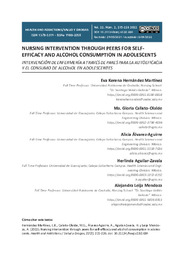Por favor, use este identificador para citar o enlazar este ítem:
https://hdl.handle.net/11000/29325Registro completo de metadatos
| Campo DC | Valor | Lengua/Idioma |
|---|---|---|
| dc.contributor.author | Hernández Martínez, Eva Kerena | - |
| dc.contributor.author | Calixto-Olalde, Ma. Gloria | - |
| dc.contributor.author | Álvarez-Aguirre, Alicia | - |
| dc.contributor.author | Aguilar-Zavala, Herlinda | - |
| dc.contributor.author | Leija Mendoza, Alejandra | - |
| dc.contributor.other | Departamentos de la UMH::Psicología de la Salud | es_ES |
| dc.date.accessioned | 2023-07-03T08:02:53Z | - |
| dc.date.available | 2023-07-03T08:02:53Z | - |
| dc.date.created | 2022 | - |
| dc.identifier.citation | Health and Addictions / Salud y Drogas, 22(2) | es_ES |
| dc.identifier.issn | 1988-205X | - |
| dc.identifier.uri | https://hdl.handle.net/11000/29325 | - |
| dc.description.abstract | Introduction: Alcohol consumption is a problem closely related to adolescence. At first, it tends to be established as a habit and after that as an addiction, when the individual in question still is an adolescent. Objective: The study sought to determine the effect caused by nursing intervention through “interconnected” peers on self-efficacy and alcohol consumption. Results: Statistically significant difference was shown post-intervention (z = -4.86; p = .000) and at follow-ups at three months (z = -4.78; p = .000) and six months (z = -4.78; p = .000); this is also activate in alcohol consumption at the post-intervention measurement (z = -4.74; p = .000) and at follow-ups at three months (z = -4.74; p = .000) and six months (z = -4.74; p = .000). Conclusions: Based on the objective of the study, it is pos-sible to conclude that it is feasible to decrease alcohol consumption and favor self-efficacy in adolescents through “interconnected”. | es_ES |
| dc.description.abstract | Introducción: El consumo de alcohol es un problema muy relacionado con la adolescencia en un principio tiende a establecer como un hábito y luego como una adicción, cuando el individuo es un adolescente. Objetivo: El estudio buscó determinar el efecto en la autoeficacia y consumo de alcohol de la intervención de enfermería a través de pa-res “interconectados”. Resultados: Se mostró diferencia estadísticamente significativa posterior a la intervención (z = -4.86; p = .000) y en los seguimientos de tres (z = -4.78; p = .000) y seis meses (z = -4.78; p = .000), esto también se activa en el consumo de alcohol en la medición posterior a la intervención (z = -4.74; p = .000) y en los seguimientos de tres (z = -4.74; p = .000) y seis meses (z = -4,74; p = .000). Conclusiones: En base al objetivo del estudio es posible concluir que es factible disminuir el consumo de alcohol y favorecer la autoeficacia en los adolescentes mediante “interconectados”. | es_ES |
| dc.format | application/pdf | es_ES |
| dc.format.extent | 12 | es_ES |
| dc.language.iso | eng | es_ES |
| dc.publisher | Universidad Miguel Hernández de Elche | es_ES |
| dc.rights | info:eu-repo/semantics/openAccess | es_ES |
| dc.rights.uri | http://creativecommons.org/licenses/by-nc-nd/4.0/ | * |
| dc.subject | Autoeficacia | es_ES |
| dc.subject | consumo de alcohol | es_ES |
| dc.subject | adolescentes | es_ES |
| dc.subject | intervención | es_ES |
| dc.subject.other | CDU::1 - Filosofía y psicología::159.9 - Psicología | es_ES |
| dc.title | Nursing intervention through peers for selfefficacy and alcohol consumption in adolescents | es_ES |
| dc.type | info:eu-repo/semantics/article | es_ES |
| dc.relation.publisherversion | https://doi.org/10.21134/haaj.v22i2.684 | es_ES |

Ver/Abrir:
684-Texto del artículo-3874-2-10-20220726 (1).pdf
365,54 kB
Adobe PDF
Compartir:
 La licencia se describe como: Atribución-NonComercial-NoDerivada 4.0 Internacional.
La licencia se describe como: Atribución-NonComercial-NoDerivada 4.0 Internacional.
.png)